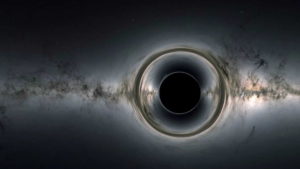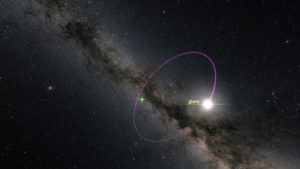The largest known Massive black hole to date has been discovered by astronomers inside the Milky Way galaxy. Astronomers made this amazing discovery after spotting an odd wobble in space which helped them locate the gigantic black hole.
A Recently Found, Massive Black Hole Is Shown in the Milky Way, Lying Close to Earth. This wonder is discovered by Monitoring the Motion of Billions of Stars in Our Galaxy with the European Space Telescope Gaia.
James Webb Space Telescope Reveals ‘Extremely Red’ Supermassive Black Hole Emerging in the Dark Depths of the Early Universe.
The recent discovery marks a significant milestone as it represents the first instance of a stellar-mass black hole, formed from the collapse of a massive star, being detected near Earth.
Astronomers discovered this black hole while examining data gathered by the European Space Agency’s Gaia space telescope, which was meant for an impending scientific data release.
The researchers were amazed by an unusual motion that they later determined was caused by Gaia BH3’s gravitational attraction on a nearby cosmic buddy.
The Particulars of Massive black hole

Gaia BH3 dubbed the ‘sleeping giant,’ was found lately and has a mass almost 33 times greater than our sun. It is the second-closest known black hole to Earth, located 1,926 light-years distant in the Aquila constellation. The nearest, Gaia BH1, is almost 1,500 light-years away and has a mass that is nearly ten times greater than our sun.
With an estimated mass of about 20 solar masses, the most massive black hole of this kind in the Milky Way was previously located in an X-ray binary in the Cygnus constellation (Cyg X-1). Stellar-mass black holes in our galaxy weigh roughly ten times as much as the sun on average.
At around 2,000 light-years away, Gaia-BH3 is the second-closest black hole ever found, which makes it an amazing object. The closest, Gaia-BH1 (also discovered by Gaia), is located 1,560 light-years away and has a mass that is significantly lower than Gaia-BH3 roughly 9.6 times that of the sun.

Since dormant black holes don’t produce any light, they are difficult to find because they frequently don’t have a nearby companion for nutrition. Nevertheless, star black holes with companions take material from them, which causes them to emit brilliant X-rays that may be seen with telescopes.
Furthermore, research shed light on the origins of these massive cosmic objects in addition to confirming the mass of the black hole. These results were released in the Astronomy & Astrophysics journal on Tuesday.
This unexpected discovery of a nearby high-mass black hole took researchers by surprise. Finding such a remarkable object is a once-in-a-lifetime experience in our research activities.

It is really amazing how much Gaia is influencing astronomy and astrophysics. Its findings extend well beyond the mission’s initial objective of creating an exact multi-dimensional map of over a billion stars within our Milky Way.
This black hole, originating from a stellar source, is the most massive in our galaxy and the second closest one found to date.
As large stars approach the conclusion of their life cycles, they suddenly collapse dramatically, giving birth to stellar black holes. Many are in the Milky Way, but the majority have masses about ten times that of the sun.
The most amazing black hole in our galaxy, Sagittarius A, has a mass of several million suns. It originated not from the explosion of a star but rather from the collapse of massive clouds of gas and dust, nestled at the center of the Milky Way.
A massive black hole is one of the incredible discoveries in the vast exploration of wonders of space. it is truly an accomplishment for astronomers.













